Numerical and Experimental Investigation of External Characteristics and Pressure Fluctuation of a Submersible Tubular Pumping System
Abstract
1. Introduction
2. Numerical Simulation
2.1. Pump Geometry
2.2. Pump Modeling
2.3. Numerical Model and Grid Generation
3. Experiment System
3.1. Test Bench
3.2. Pressure Pulsation Measurement
4. Results and Analysis
4.1. External Characteristics of Pumping System
4.2. Pressure Pulsation Analysis
5. Conclusions
- (1)
- Comparing the numerical simulation results and experimental data of pump performance under different working conditions, the results of the calculation and the experiment are in good agreement, especially in the high efficiency area, and some deviations under high flow and small flow conditions.
- (2)
- The pressure pulsation values of the six monitoring points in the axial direction of the wall of the pumping system calculated by the unsteady simulation are basically the same as the overall trend of the pressure pulsation test results. The pressure fluctuation intensity is strongest in the impeller outlet, and then it gradually weakens. The main frequency and the amplitude matching degree are higher, and the pressure pulsation values on the wall of the bulb unit are quite different.
- (3)
- The blade passing frequency and its multiples play a leading role in pressure pulsation. Due to the rotor–stator interaction at the exit of the impeller, the influence of the blade frequency is obvious. The farther the measuring point is from the impeller, the less affected the pressure pulsation is by the blade frequency. The frequency amplitudes decrease from the impeller exit to the bulb unit.
- (4)
- Based on this research, the experimental pressure pulsation monitoring points can be increased in the future to further reveal the internal pulsation distribution law of submersible tubular pumping systems.
Author Contributions
Funding
Conflicts of Interest
Nomenclature
| A | Amplitude, Pa |
| F | Actual frequency after Fourier transform, Hz |
| Fn | Blade passing frequency, Hz |
| g | Gravity, m/s2 |
| H | Lift head, m |
| M | Torque, Nm |
| n | Rotational speed, r/min |
| NF | Rotational frequency multiple |
| p1,p2 | Static pressure of section A-A and B-B, Pa |
| P | Shaft power, kW |
| Q | Discharge, L/s |
| Qopt | Discharge of optimal condition, L/s |
| T | Period, s |
| V1,V2 | Flow velocity of section A-A and B-B, m/s |
| z | Blade number of impeller, 3 |
| η | Efficiency |
| ρ | Density of water, kg/m3 |
| ω | Angular velocity of rotation, rad/s |
| △t | Time step, s |
References
- Wu, C.; Jin, Y.; Wang, D.; Yang, H.; Yang, F.; Liu, C. Study and application of large bidirectional submersible tubular pump system. J. Hydroelectr. Eng. 2012, 31, 265–270. [Google Scholar]
- Liu, C.; Zhou, Q.; Qian, J.; Jin, Y. Flow characteristics of two way passage vertical submersible pump system. Trans. Chin. Soc. Agric. Mach. 2016, 47, 59–65. [Google Scholar]
- Tang, F.; Liu, C.; Xie, W. Experimental studies on hydraulic Models for a reversible, Tubular, and Submersible axial-flow P ump Installation. Trans. Chin. Soc. Agric. Mach. 2004, 35, 74–77. [Google Scholar]
- Yang, F.; Jin, Y.; Liu, C. Performance test and numerical analysis of bidirectional submersible tubular pump. J. Agric. Eng. 2012, 28, 60–67. [Google Scholar]
- Xia, C. Research on the flow pattern of low-lift diving tubular pumping system by 3D CFD. Earth Environ. Sci. 2016, 49, 032010. [Google Scholar] [CrossRef]
- Zhu, Y.; Tang, S.; Wang, C.; Jiang, W.; Yuan, X.; Lei, Y. Bifurcation Characteristic research on the load vertical vibration of a hydraulic automatic gauge control system. Processes 2019, 7, 718. [Google Scholar] [CrossRef]
- Zhu, Y.; Qian, P.; Tang, S.; Jiang, W.; Li, W.; Zhao, J. Amplitude-frequency characteristics analysis for vertical vibration of hydraulic AGC system under nonlinear action. Aip Adv. 2019, 9, 035019. [Google Scholar] [CrossRef]
- Ye, S.; Zhang, J.; Xu, B.; Zhu, S. Theoretical investigation of the contributions of the excitation forces to the vibration of an axial piston pump. Mech. Syst. Signal Process. 2019, 129, 201–217. [Google Scholar] [CrossRef]
- Khalifa, A.E.; Al-Qutub, A.M.; Ben-Mansour, R. Study of pressure fluctuations and induced vibration at blade-passing frequencies of a double volute pump. Arab. J. Sci. Eng. 2011, 36, 1333–1345. [Google Scholar] [CrossRef]
- Zhang, J.; Xia, S.; Ye, S.; Xu, B.; Song, W.; Zhu, S.; Xiang, J. Experimental investigation on the noise reduction of an axial piston pump using free-layer damping material treatment. Appl. Acoust. 2018, 139, 1–7. [Google Scholar] [CrossRef]
- Chu, S.; Dong, R.; Katz, J. Relationship between unsteady flow, pressure fluctuations, and noise in a centrifugal pump—part A: Use of PDV data to compute the pressure field. J. Fluids Eng. 1995, 117, 24–29. [Google Scholar] [CrossRef]
- Chu, S.; Dong, R.; Katz, J. Relationship between unsteady flow, pressure fluctuations, and noise in a centrifugal pump—Part B: Effects of blade-tongue interactions. J. Fluids Eng. 1995, 117, 30–35. [Google Scholar] [CrossRef]
- Parrondo, J.; Pérez, J.; Barrio, R.; Gonzales, J. A simple acoustic model to characterize the internal low frequency sound field in centrifugal pumps. Appl. Acoust. 2011, 72, 59–64. [Google Scholar] [CrossRef]
- He, X.; Jiao, W.; Wang, C.; Cao, W. Influence of surface roughness on the pump performance based on Computational Fluid Dynamics. IEEE Access 2019, 7, 105331–105341. [Google Scholar] [CrossRef]
- Wang, C.; Hu, B.; Zhu, Y.; Wang, X.; Luo, C.; Cheng, L. Numerical study on the gas-water two-phase flow in the self-priming process of self-priming centrifugal pump. Processes 2019, 7, 330. [Google Scholar] [CrossRef]
- Si, Q.; Yuan, J.; Yuan, S.; Wang, W.; Zhu, L.; Bois, G. Numerical investigation of pressure fluctuation in centrifugal pump volute vased on SAS model and experimental validation. Adv. Mech. Eng. 2014, 6, 972081. [Google Scholar] [CrossRef]
- Li, Y.; Li, X.; Zhu, Z.; Li, F. Investigation of unsteady flow in a centrifugal pump at low flow rate. Adv. Mech. Eng. 2016, 8, 1–8. [Google Scholar] [CrossRef]
- Dai, C.; Kong, F.; Dong, L. Pressure fluctuation and its influencing factors in circulating water pump. J. Cent. South Univ. 2013, 20, 149–155. [Google Scholar] [CrossRef]
- Wang, C.; He, X.; Zhang, D.; Hu, B.; Shi, W. Numerical and experimental study of the self-priming process of a multistage self-priming centrifugal pump. Int. J. Energy Res. 2019, 43, 4074–4092. [Google Scholar] [CrossRef]
- Wang, C.; He, X.; Shi, W.; Wang, X.; Wang, X.; Qiu, N. Numerical study on pressure fluctuation of a multistage centrifugal pump based on whole flow field. Aip Adv. 2019, 9, 035118. [Google Scholar] [CrossRef]
- Feng, J.; Benra, F.K.; Dohmen, H.J. Unsteady flow investigation in rotor-stator interface of a radial diffuser pump. Forsch. Ingen. 2010, 74, 233–242. [Google Scholar] [CrossRef]
- Wang, C.; Shi, W.; Wang, X.; Jiang, X.; Yang, Y.; Li, W.; Zhou, L. Optimal design of multistage centrifugal pump based on the combined energy loss model and computational fluid dynamics. Appl. Energy 2017, 187, 10–26. [Google Scholar] [CrossRef]
- Pavesi, G.; Cavazzini, G.; Ardizzon, G. Time-frequency characterization of the unsteady phenomena in a centrifugal pump. Int. J. Heat Fluid Flow 2008, 29, 1527–1540. [Google Scholar] [CrossRef]
- Xie, C.; Tang, F.; Zhang, R.; Zhou, W.; Zhang, W.; Yang, F. Numerical calculation of anial-flow pump’s pressure fluctuation and model test analysis. Adv. Mech. Eng. 2018, 10, 1–13. [Google Scholar] [CrossRef]
- Feng, J.; Luo, X.; Guo, P.; Wu, G. Influence of tip clearance on pressure fluctuations in an axial flow pump. J. Mech. Sci. Technol. 2016, 30, 1603–1610. [Google Scholar] [CrossRef]
- Wang, F.; Zhang, L.; Zhang, Z. Analysis on pressure fluctuation of unsteady flow in axial-flow pump. J. Hydraul. Eng. 2007, 38, 1003–1009. [Google Scholar]
- Zhang, D.; Wang, H.; Shi, W.; Pan, D.; Shao, P. Experimental investigation of pressure fluctuation with multiple flow rates in scaled axial flow pump. Trans. Chin. Soc. Agric. Mach. 2014, 45, 139–145. [Google Scholar]
- Zhang, D.; Geng, L.; Shi, W.; Pan, D.; Wang, H. Experimental investigation on pressure fluctuation and vibration in axial-flow pump model. Trans. Chin. Soc. Agric. Mach. 2015, 46, 66–72. [Google Scholar]
- Gao, Q. Study of Pressure Fluctuation in a Mixed-Flow Pump with Vaned Diffuser; Lanzhou University of Technology: Lanzhou, China, 2014. [Google Scholar]
- Yang, F.; Liu, C.; Tang, F.; Zhou, J.; Cheng, L. Numerical analysis on pressure fluctuations of time-varying turbulent flow in tubular pumping system with S-shaped shaft extension. J. Hydroelectr. Eng. 2015, 34, 175–180. [Google Scholar]
- Zhang, Y.; Wang, X.; Ding, P.; Tang, X. Numerical analysis of pressure fluctuation of internal flow in submersible axial-flow pump. J. Drain. Irrig. Mach. Eng. 2014, 32, 302–307. [Google Scholar]
- Jin, Y.; Liu, C.; Qiu, Z.; Zhou, J.; Cheng, L. Numerical simulation and experimental study on postpositive bulb tubular pump. In Proceedings of the 6th International Symposium on Fluid Machinery and Fluid Engineering, Wuhan, China, 22–25 October 2014. [Google Scholar]

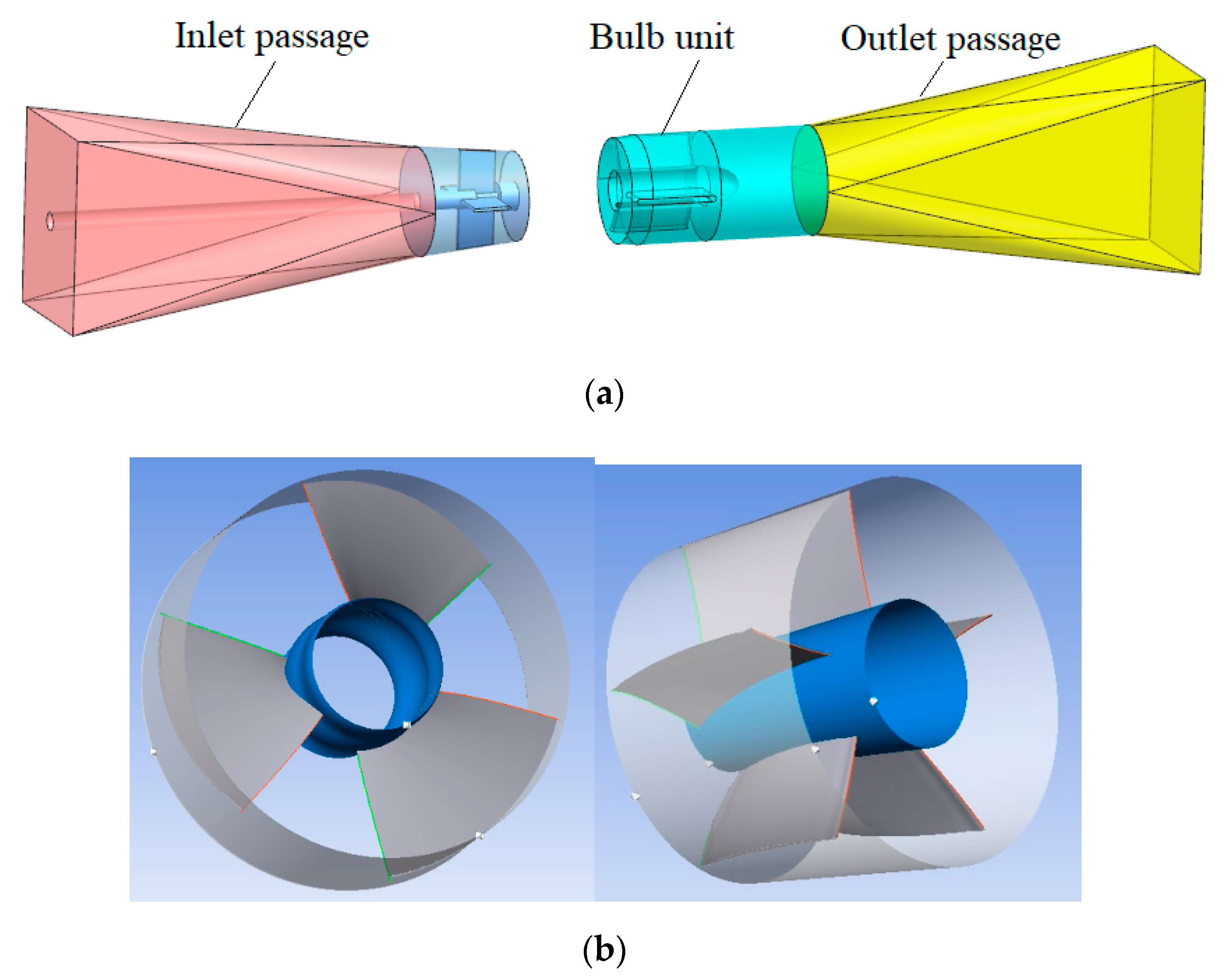
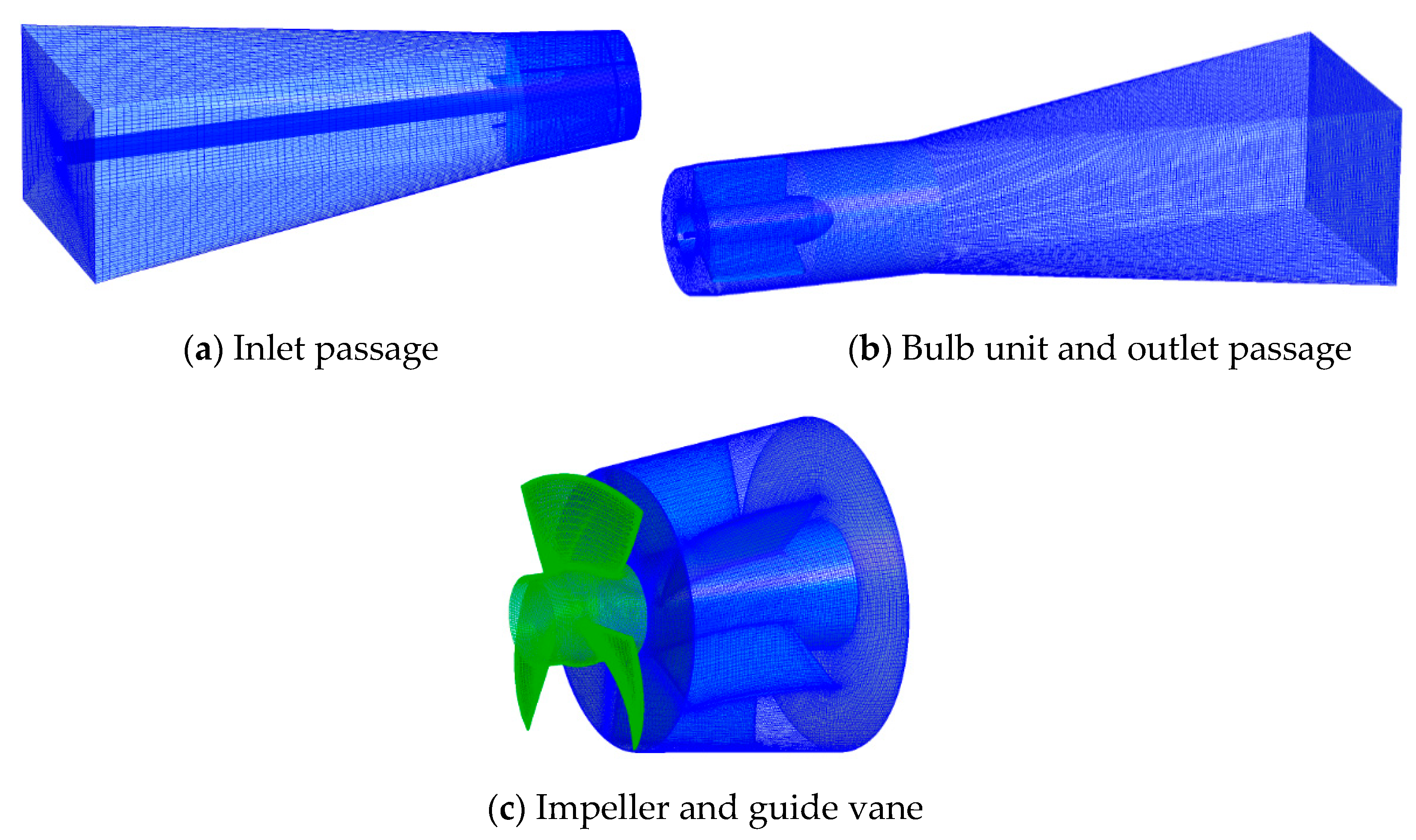
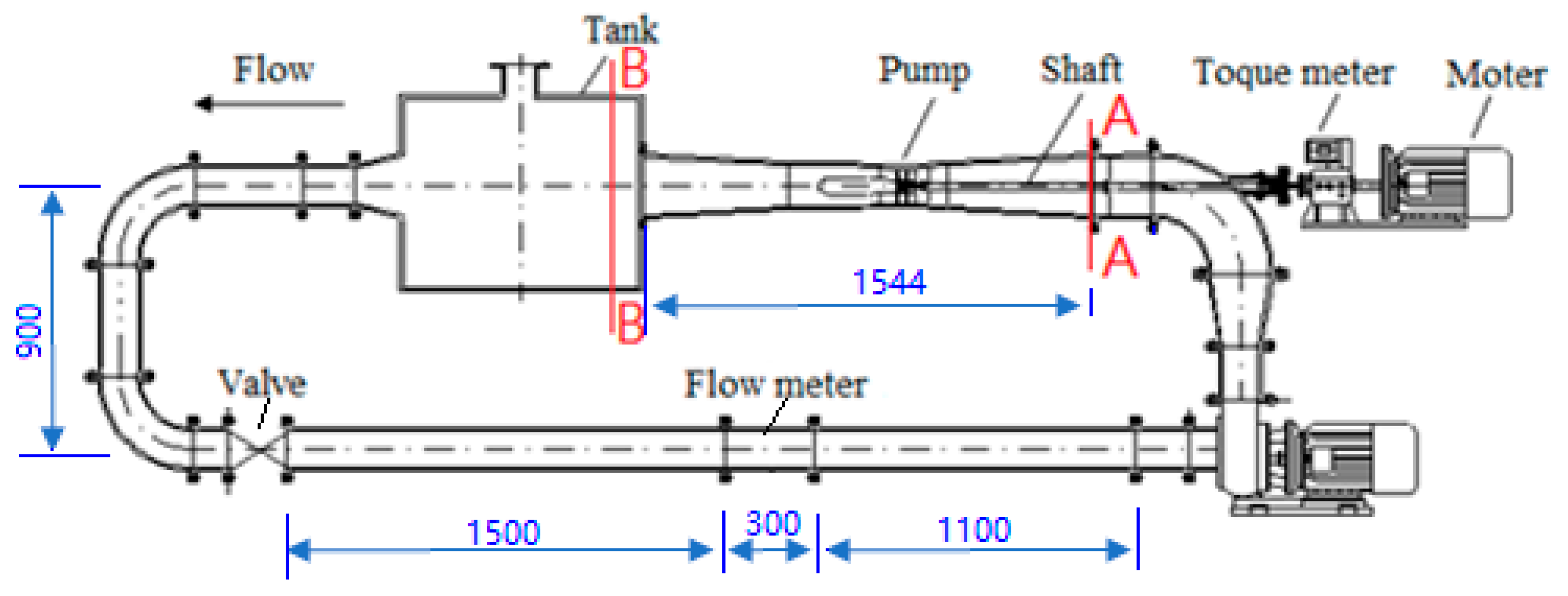

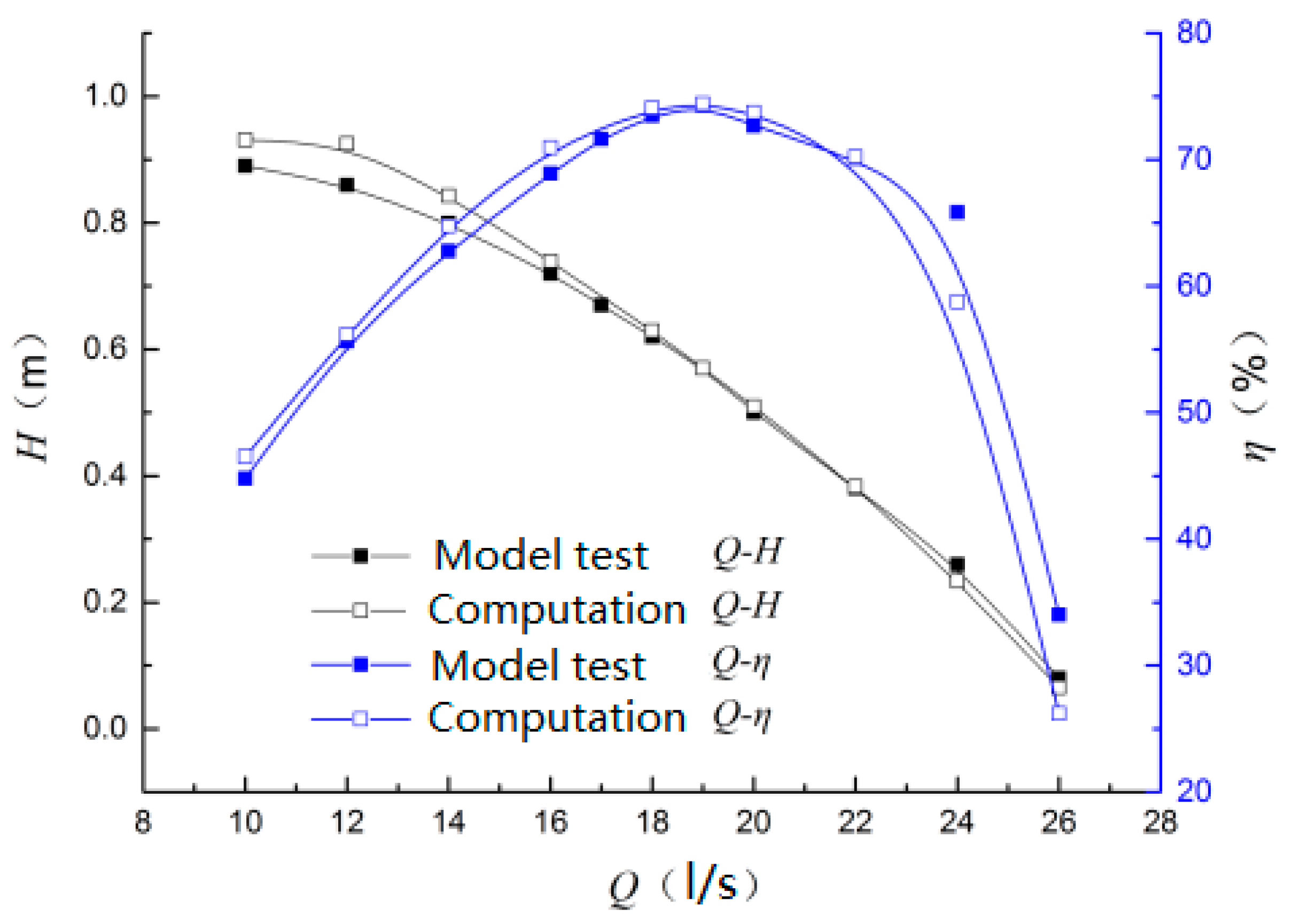
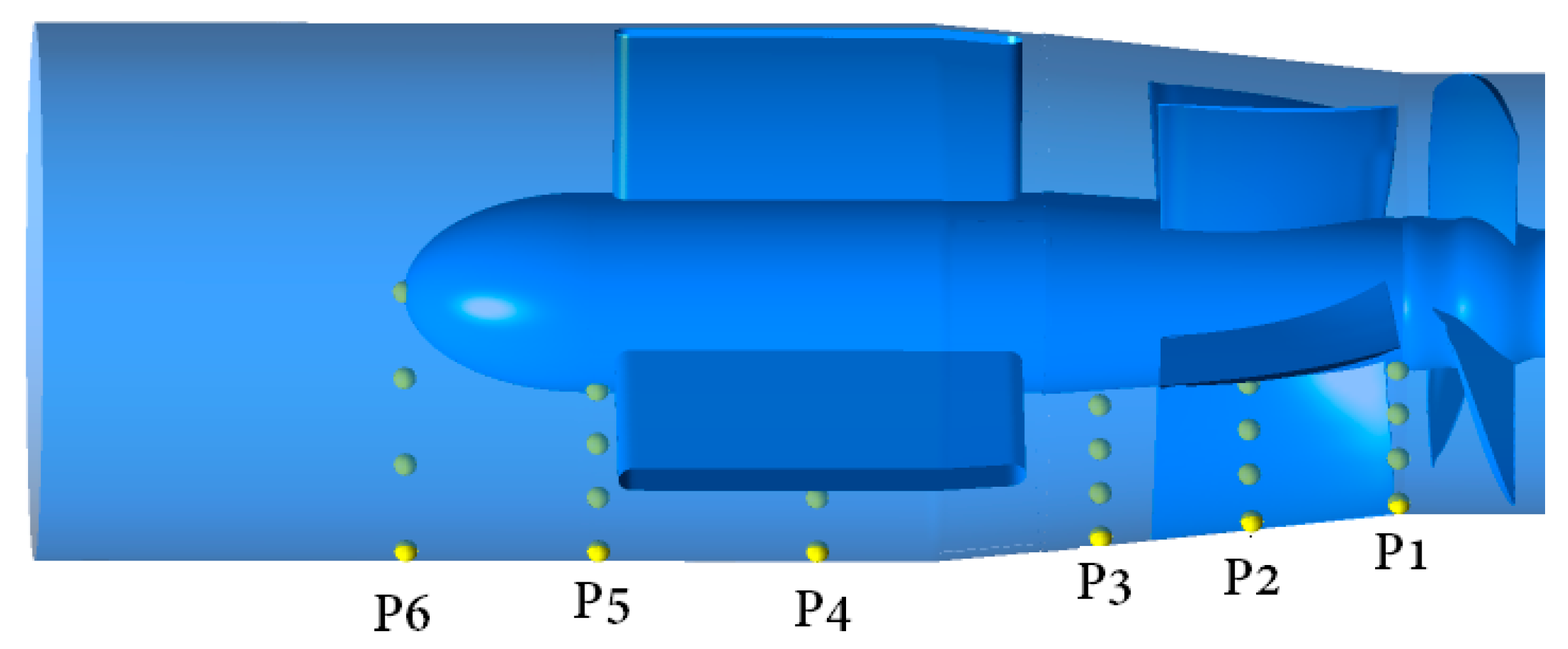
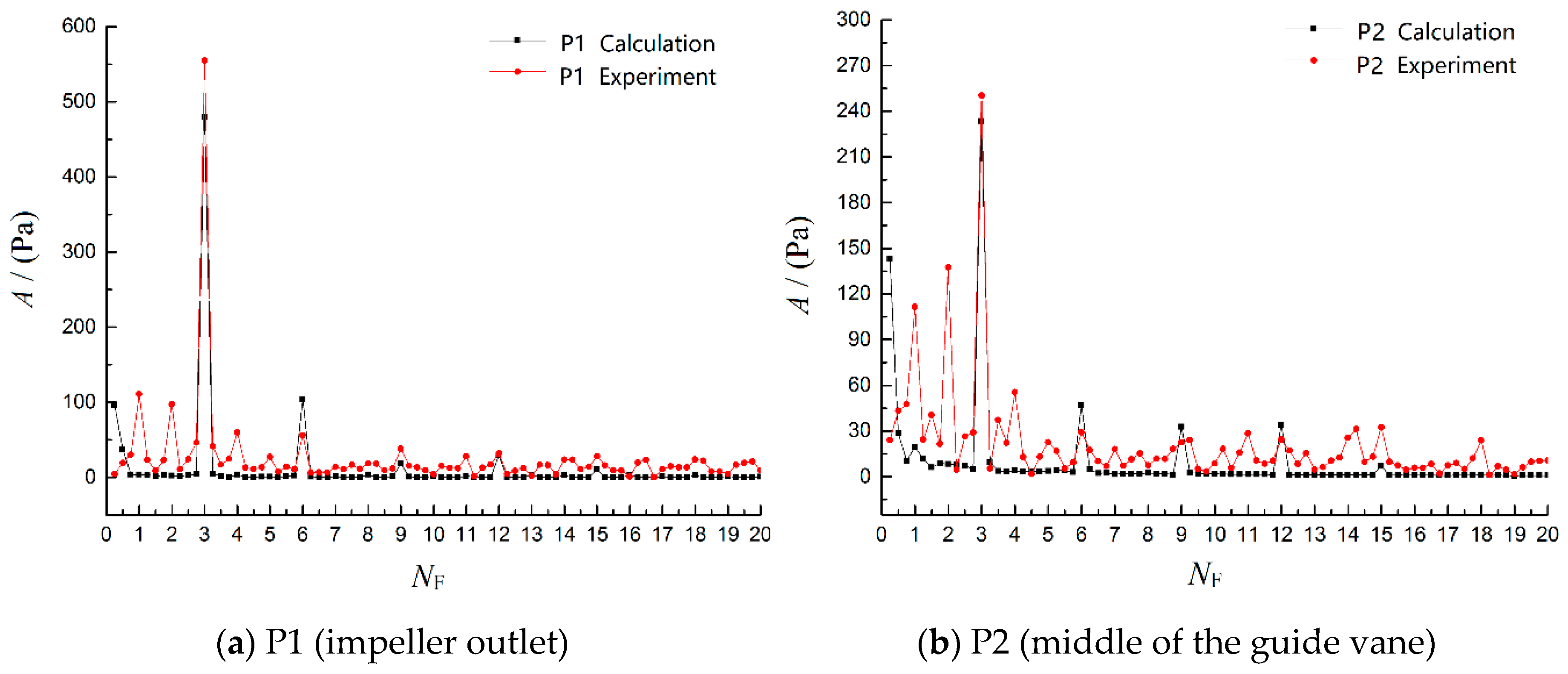

| Impeller diameter (mm) | 120 |
| Rotational speed (r/min) | 1450 |
| Hub to tip ratio | 0.4 |
| Discharge range (L/s) | 14~24 |
| Number of blades | 3 |
| Number of guide vane blades | 5 |
| Blade angle (°) | 0 |
| Tip clearance (mm) | 0.2 |
| Sensor Model | CYG1505GSLF |
|---|---|
| Range (kPa) | 50 |
| Output (V) | 0~5 |
| Accuracy (%) | 0.25 |
© 2019 by the authors. Licensee MDPI, Basel, Switzerland. This article is an open access article distributed under the terms and conditions of the Creative Commons Attribution (CC BY) license (http://creativecommons.org/licenses/by/4.0/).
Share and Cite
Jin, Y.; He, X.; Zhang, Y.; Zhou, S.; Chen, H.; Liu, C. Numerical and Experimental Investigation of External Characteristics and Pressure Fluctuation of a Submersible Tubular Pumping System. Processes 2019, 7, 949. https://doi.org/10.3390/pr7120949
Jin Y, He X, Zhang Y, Zhou S, Chen H, Liu C. Numerical and Experimental Investigation of External Characteristics and Pressure Fluctuation of a Submersible Tubular Pumping System. Processes. 2019; 7(12):949. https://doi.org/10.3390/pr7120949
Chicago/Turabian StyleJin, Yan, Xiaoke He, Ye Zhang, Shanshan Zhou, Hongcheng Chen, and Chao Liu. 2019. "Numerical and Experimental Investigation of External Characteristics and Pressure Fluctuation of a Submersible Tubular Pumping System" Processes 7, no. 12: 949. https://doi.org/10.3390/pr7120949
APA StyleJin, Y., He, X., Zhang, Y., Zhou, S., Chen, H., & Liu, C. (2019). Numerical and Experimental Investigation of External Characteristics and Pressure Fluctuation of a Submersible Tubular Pumping System. Processes, 7(12), 949. https://doi.org/10.3390/pr7120949





